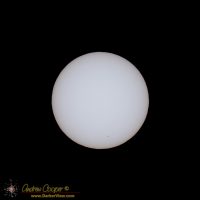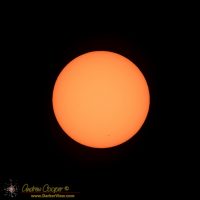When travelling to an eclipse, one solar filter is not enough. I need a backup!

Having the two filters available for use mean I must choose between them when the moment is critical. Which is better? Some testing is in order to find out.
The two filters appear very different, the thin silver film of the Baader quite different than the thicker black polymer film of the Orion filter. Both filters are safe to use and provide decent solar viewing. Both provided pleasing solar images using my Televue 76mm APO telescope at low and medium power.
Stepping beyond basic use I do find that they perform quite differently. So differently I felt some notes are in order.
Baader Solar Film

The film is available as visual with an optical density (OD) of 5.0. Or you can buy the photographic version that blocks less light to allow faster exposures. As the photo version can not be safely used for visual observing most just buy the darker film and use it for both visual and photographic needs.
Of course Baader film is generally supplied without a mount, simply as a sheet of film you must mount yourself. It is not much trouble to make a simple mount for the film. I got fancy and machined an aluminum ring for the job, the film is simply glued to the inside of the ring.
The very thin film ensures the image quality is not affected by passing through the filter. In optical terms the film is called a pellicle. Pellicles are used where interference fringes or secondary reflections in a layer of glass would otherwise be an issue.
One drawback to the Baader film is the resulting blue-white color of the solar image. While arguably more accurate, the blue hue is confusing to many viewers. When used for public observing many inexperienced viewers will see the blue disk and assume they are looking at a patch of sky though the telescope.
The photos from a Baader film filter are likewise confusing in appearance, not the color most associate with our Sun. Most astrophotographers who use the film will modify the hue to the more expected golden yellow in processing.
One advantage of the Baader film is the resulting blue-white color of the solar image. As the image is white, all of the pixels in a digital camera will record the Sun. A filter with a orange-gold image will expose on primarily on the red pixels, three quarters of the pisels in a standard Bayer pattern record a weak image.
The Baader film also offered a notably brighter image, which allows shorter exposures. This is important to reduce blurring due to telescope vibrations or atmospheric distortion.
Another advantage of the Baader film is the very minimal optical thickness. Besides providing very little distortion in the image, this avoids any focus change when the filter is removed. During this upcoming eclipse this will be important. The lack of focus shift will allow focusing during the partial stage, and simply removing the filter for totality without a need to recheck focus during the precious moments of totality.
It is Baader film I used for the Venus Transit in 2012. I was extremely impressed with its performance, the views of this one-in-a-lifetime event were sharp and beautiful. We had spectacular seeing atop Mauna Kea and I did not see the black dot effect, instead I saw the Aureole of Venus, a delicate sight that is one of the most beautiful things I have ever seen in a telescope.
Orion Solar Safety Film

These filters can be ordered directly from the Orion Telescope website. Cost for the 4″ filter is also a very reasonable $25 plus shipping.
The construction of the filter is very inexpensive, actually a cardboard cap for the end of the telescope. Despite this the cardboard the filter seems well made and reliable.
The resulting image is a familiar orange-yellow. It just looks like the Sun to most people, immediately recognizable. Likewise the color of photographs through this filter do not need any color modification in editing.
An adhesive backed felt strip is supplied to aid in fitting the filter to the telescope. The cap is deep enough to be reasonably secure, but like most filters I find myself using a couple pieces of gaffers tape to secure it beyond any risk of coming off.
The Orion film filter has another advantage, it is thick enough to be fairly difficult to damage. I will not use the Baader film for public viewing for a couple reasons, the confusing blue color of the image is a problem. Also the possibility that some inquisitive finger will damage the filter and create a hazard resulting in an eye injury.
Wrapup…
Both filters are fairly inexpensive and safe solutions. The Baader is sharper and is better for photography. The Orion is tougher and offers a yellow-gold image most people see as more natural.
I expect I will leave the Baader filter in the case until the eclipse or photography, using the Orion filter for general solar viewing in the days and hours leading up to this event.

